simple poems 英文诗歌教学
- 格式:pptx
- 大小:8.45 MB
- 文档页数:15
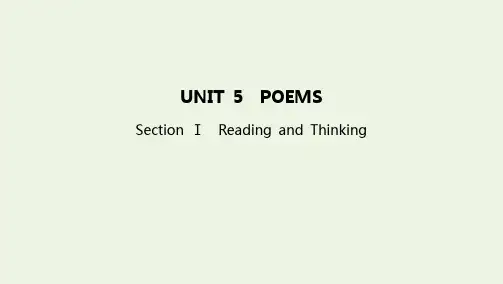
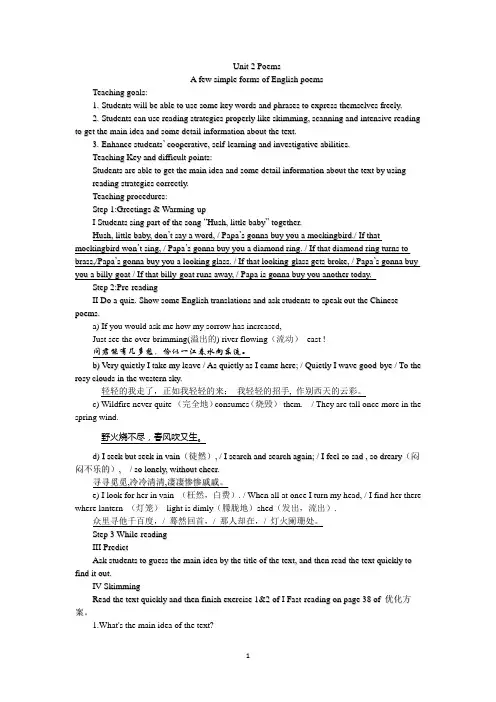
U n i t2P o e m sA f e w s i m p l e f o r m s o f E n g l i s h p o e m sT e a c h i n g g o a l s:1.S t u d e n t s w i l l b e a b l e t o u s e s o m e k e y w o r d s a n d p h r a s e s t o e x p r e s s t h e m s e l v e s f r e e l y.2.S t u d e n t s c a n u s e r e a d i n g s t r a t e g i e s p r o p e r l y l i k e s k i m m i n g,s c a n n i n g a n d i n t e n s i v e r e a d i n g t o g e t t h e m a i n i d e a a n d s o m e d e t a i l i n f o r m a t i o n a b o u t t h e t e x t.3.E n h a n c e s t u d e n t s’c o o p e r a t i v e,s e l f-l e a r n i n g a n d i n v e s t i g a t i v e a b i l i t i e s.T e a c h i n g K e y a n d d i f f i c u l t p o i n t s:S t u d e n t s a r e a b l e t o g e t t h e m a i n i d e a a n d s o m e d e t a i l i n f o r m a t i o n a b o u t t h e t e x t b y u s i n gr e a d i n g s t r a t e g i e s c o r r e c t l y.T e a c h i n g p r o c e d u r e s:S t e p1:G r e e t i n g s&W a r m i n g-u pI S t u d e n t s s i n g p a r t o f t h e s o n g“H u s h,l i t t l e b a b y”t o g e t h e r.H u s h,l i t t l e b a b y,d o n’t s a y a w o r d,/P a p a’s g o n n a b u y y o u a m o c k i n g b i r d./I f t h a tm o c k i n g b i r d w o n’t s i n g,/P a p a’s g o n n a b u y y o u a d i a m o n d r i n g./I f t h a t d i a m o n d r i n g t u r n s t ob r a s s,/P a p a’s g o n n a b u y y o u a l o o k i n g g l a s s./I f t h a t l o o k i n g-g l a s s g e t s b r o k e,/P a p a’s g o n n a b u y y o u a b i l l y-g o a t/I f t h a t b i l l y-g o a t r u n s a w a y,/P a p a i s g o n n a b u y y o u a n o t h e r t o d a y.S t e p2:P r e-r e a d i n gII D o a q u i z.S h o w s o m e E n g l i s h t r a n s l a t i o n s a n d a s k s t u d e n t s t o s p e a k o u t t h e C h i n e s ep o e m s.a) If you would ask me how my sorrow has increased,Just see the over-brimming(溢出的) river flowing(流动)east !问君能有几多愁,恰似一江春水向东流。
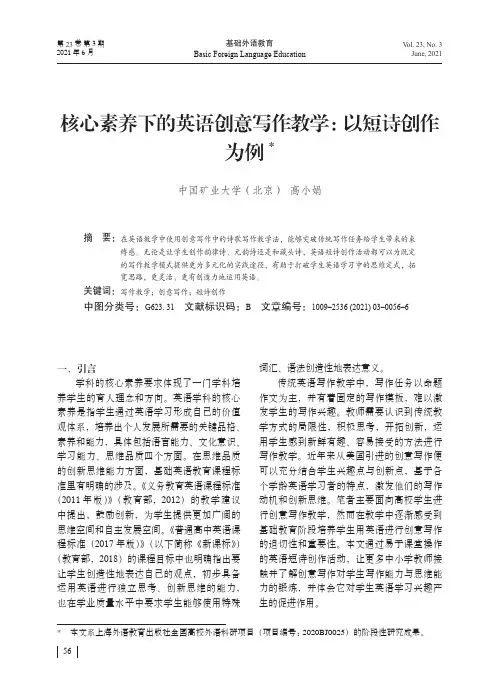
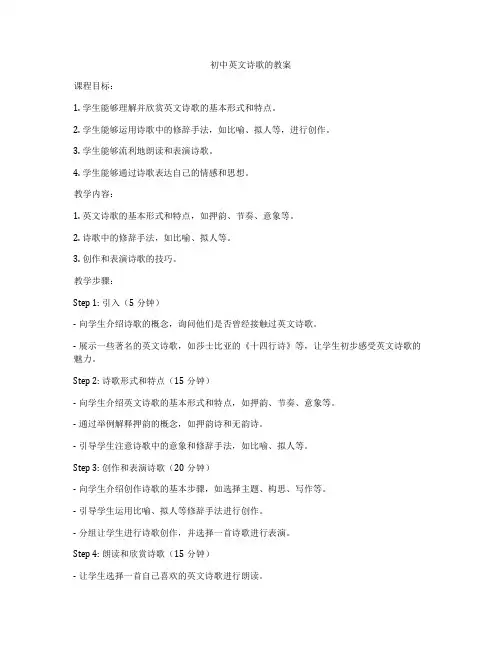
初中英文诗歌的教案课程目标:1. 学生能够理解并欣赏英文诗歌的基本形式和特点。
2. 学生能够运用诗歌中的修辞手法,如比喻、拟人等,进行创作。
3. 学生能够流利地朗读和表演诗歌。
4. 学生能够通过诗歌表达自己的情感和思想。
教学内容:1. 英文诗歌的基本形式和特点,如押韵、节奏、意象等。
2. 诗歌中的修辞手法,如比喻、拟人等。
3. 创作和表演诗歌的技巧。
教学步骤:Step 1: 引入(5分钟)- 向学生介绍诗歌的概念,询问他们是否曾经接触过英文诗歌。
- 展示一些著名的英文诗歌,如莎士比亚的《十四行诗》等,让学生初步感受英文诗歌的魅力。
Step 2: 诗歌形式和特点(15分钟)- 向学生介绍英文诗歌的基本形式和特点,如押韵、节奏、意象等。
- 通过举例解释押韵的概念,如押韵诗和无韵诗。
- 引导学生注意诗歌中的意象和修辞手法,如比喻、拟人等。
Step 3: 创作和表演诗歌(20分钟)- 向学生介绍创作诗歌的基本步骤,如选择主题、构思、写作等。
- 引导学生运用比喻、拟人等修辞手法进行创作。
- 分组让学生进行诗歌创作,并选择一首诗歌进行表演。
Step 4: 朗读和欣赏诗歌(15分钟)- 让学生选择一首自己喜欢的英文诗歌进行朗读。
- 引导学生欣赏诗歌中的韵律和节奏,感受诗歌的音乐性。
Step 5: 总结和反思(5分钟)- 让学生分享自己在创作和表演诗歌中的体会和感受。
- 引导学生反思通过学习诗歌,自己对语言和表达的理解是否有新的认识。
教学评估:1. 观察学生在创作和表演诗歌中的表现,评估学生对诗歌形式和特点的理解程度。
2. 学生对诗歌的朗读和欣赏,评估学生对诗歌的感悟和表达能力。
教学资源:1. 英文诗歌的文本材料,如莎士比亚的《十四行诗》等。
2. 诗歌创作的参考资料和指导书籍。
教学建议:1. 在教学过程中,注重引导学生通过朗读和欣赏来感受诗歌的魅力。
2. 在创作环节,鼓励学生发挥想象,大胆运用修辞手法。
3. 鼓励学生在课堂上积极发言,分享自己的思考和感受。
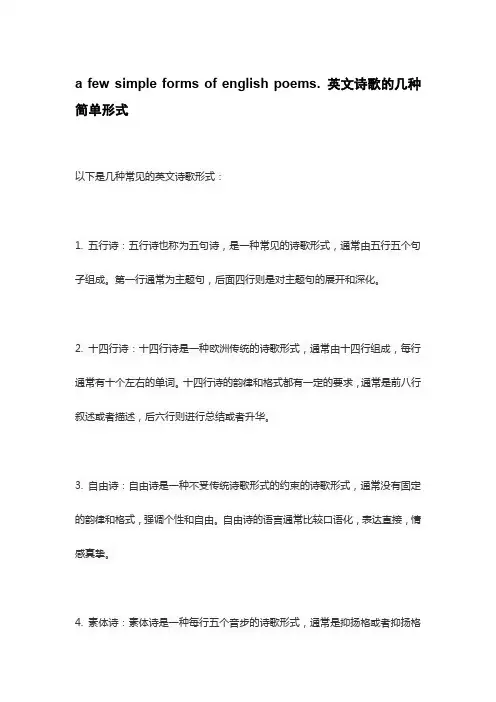
a few simple forms of english poems. 英文诗歌的几种简单形式
以下是几种常见的英文诗歌形式:
1. 五行诗:五行诗也称为五句诗,是一种常见的诗歌形式,通常由五行五个句子组成。
第一行通常为主题句,后面四行则是对主题句的展开和深化。
2. 十四行诗:十四行诗是一种欧洲传统的诗歌形式,通常由十四行组成,每行通常有十个左右的单词。
十四行诗的韵律和格式都有一定的要求,通常是前八行叙述或者描述,后六行则进行总结或者升华。
3. 自由诗:自由诗是一种不受传统诗歌形式的约束的诗歌形式,通常没有固定的韵律和格式,强调个性和自由。
自由诗的语言通常比较口语化,表达直接,情感真挚。
4. 素体诗:素体诗是一种每行五个音步的诗歌形式,通常是抑扬格或者抑扬格
合韵。
素体诗的韵律感强,语言优美,是英文诗歌中的一种重要形式。
5. 挽歌:挽歌是一种哀悼或者纪念已故者的诗歌形式,通常比较庄重、肃穆。
挽歌的语言优美,情感真挚,常常用一些象征性的形象来表达哀思和纪念之情。
这些是英文诗歌中的几种常见形式,每种形式都有其独特的特点和要求,对于英文诗歌的创作和理解都有一定的帮助。
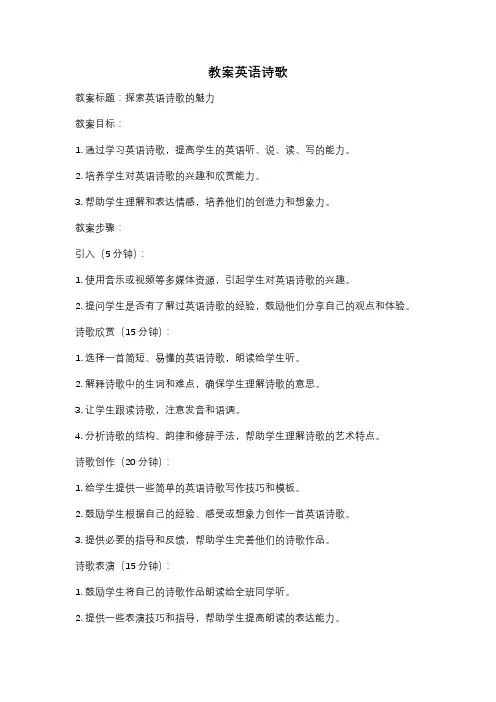
教案英语诗歌教案标题:探索英语诗歌的魅力教案目标:1. 通过学习英语诗歌,提高学生的英语听、说、读、写的能力。
2. 培养学生对英语诗歌的兴趣和欣赏能力。
3. 帮助学生理解和表达情感,培养他们的创造力和想象力。
教案步骤:引入(5分钟):1. 使用音乐或视频等多媒体资源,引起学生对英语诗歌的兴趣。
2. 提问学生是否有了解过英语诗歌的经验,鼓励他们分享自己的观点和体验。
诗歌欣赏(15分钟):1. 选择一首简短、易懂的英语诗歌,朗读给学生听。
2. 解释诗歌中的生词和难点,确保学生理解诗歌的意思。
3. 让学生跟读诗歌,注意发音和语调。
4. 分析诗歌的结构、韵律和修辞手法,帮助学生理解诗歌的艺术特点。
诗歌创作(20分钟):1. 给学生提供一些简单的英语诗歌写作技巧和模板。
2. 鼓励学生根据自己的经验、感受或想象力创作一首英语诗歌。
3. 提供必要的指导和反馈,帮助学生完善他们的诗歌作品。
诗歌表演(15分钟):1. 鼓励学生将自己的诗歌作品朗读给全班同学听。
2. 提供一些表演技巧和指导,帮助学生提高朗读的表达能力。
3. 通过表演,让学生展示他们对诗歌的理解和表达能力。
总结(5分钟):1. 回顾本节课所学的内容和经验。
2. 鼓励学生分享他们对英语诗歌的新的认识和体验。
3. 引导学生思考如何在日常生活中继续欣赏和创作英语诗歌。
教案扩展:1. 鼓励学生在课后继续阅读和欣赏英语诗歌,可以推荐一些适合他们的经典诗歌作品。
2. 组织学生参加诗歌朗诵比赛或创作比赛,激发他们的学习兴趣和竞争意识。
3. 配合其他教材和教学资源,设计更多与英语诗歌相关的活动,如诗歌翻译、诗歌分析等。
教案评估:1. 观察学生在课堂上的参与度和表现,包括对诗歌的理解和表达能力。
2. 收集学生的诗歌作品,评估他们的创作能力和语言运用水平。
3. 与学生进行个别或小组交流,了解他们对本节课的反馈和收获。
教案注意事项:1. 根据学生的年龄和英语水平,选择适当的英语诗歌。
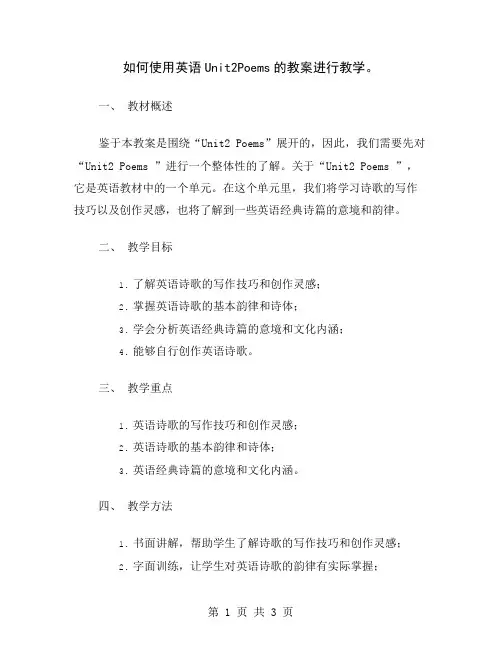
如何使用英语Unit2Poems的教案进行教学。
一、教材概述鉴于本教案是围绕“Unit2 Poems”展开的,因此,我们需要先对“Unit2 Poems ”进行一个整体性的了解。
关于“Unit2 Poems ”,它是英语教材中的一个单元。
在这个单元里,我们将学习诗歌的写作技巧以及创作灵感,也将了解到一些英语经典诗篇的意境和韵律。
二、教学目标1.了解英语诗歌的写作技巧和创作灵感;2.掌握英语诗歌的基本韵律和诗体;3.学会分析英语经典诗篇的意境和文化内涵;4.能够自行创作英语诗歌。
三、教学重点1.英语诗歌的写作技巧和创作灵感;2.英语诗歌的基本韵律和诗体;3.英语经典诗篇的意境和文化内涵。
四、教学方法1.书面讲解,帮助学生了解诗歌的写作技巧和创作灵感;2.字面训练,让学生对英语诗歌的韵律有实际掌握;3.分析诗歌,帮助学生认识英语经典诗篇的意境和文化内涵。
五、教学步骤1.教师向学生介绍“Unit 2 Poems”单元,并简要讲解本单位置的教学目标和教学重点;2.介绍英语诗歌的基本知识,包括英语诗歌的韵律和诗体等;3.教师帮助学生了解诗歌的写作技巧和创作灵感,并通过介绍一些经典的英语诗歌进行解析;4.通过字面训练,让学生练习英文诗歌的韵律和韵脚;5.分析英语经典诗篇,帮助学生认识诗歌的意境和文化内涵,并引导学生分析和创作英语诗歌;6.教师和学生互动交流,确保学生真正理解和掌握了所学知识。
六、教学效果的评估在教学的过程中,教师可以通过以下方式来评估教学的效果:1.听学生发言,了解学生是否真正明白了所学知识;2.通过分组讨论或个人笔试等方式来评估学生所掌握的知识程度;3.教师可以看学生的创作成果,来看学生是否真正掌握了诗歌的写作技巧。
七、总结通过对“Unit2 Poems ”教案的解析,可以看出,在教学过程中,我们需要充分利用各种教学资源,特别是教案资源,来为我们的教学提供有力支持。
而在具体上课过程中,我们还需要把握好教学的目标、方法和效果评估等关键点,才能真正帮助学生掌握英语诗歌的基本知识和创作技巧,从而提高学生英语语言和文学素养的水平。

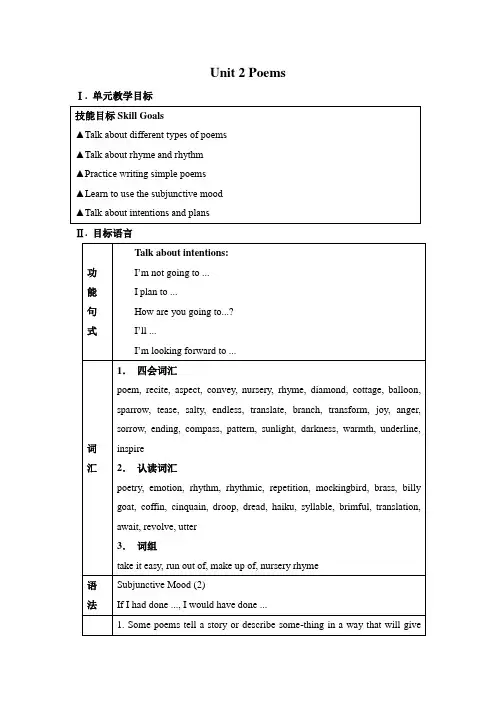
Unit 2 Poems Ⅰ. 单元教学目标Ⅱ. 目标语言Ⅲ. 教材分析与教材重组1. 教材分析本单元以Poems为话题,从学生初次接触诗歌,一直谈到诗歌创作的动机、有关诗歌的一些基本知识(包括诗歌的种类、风格)等。
旨在通过本单元的学习,使学生在初步了解和掌握诗歌这一文学形式的基本常识的基础上,进行简单的诗歌创作。
1.1 Warming Up部分要求学生回顾所学诗歌,启发学生以小组活动形式分析、列举人们进行诗歌创作的原因。
1.2 Pre-reading 部分首先要求学生说出自己最喜欢的中英文诗歌并阐明理由;然后通过快速阅读Reading部分内容填写列表,区分诗歌种类。
1.3 Reading部分是一篇介绍诗歌基础知识的文章。
文章从诗歌创作的动机、种类、特点及读者对象等方面简要介绍了五种不同风格、特色的诗歌。
1.4 Comprehending 部分根据阅读内容设置了三个习题。
第一个习题要求学生通过读文章、听录音感受诗歌特色,判断自己所喜欢的诗歌类型并说出理由;第二个习题就文章总体内容提出了五个问题,帮助学生进一步了解不同类型诗歌的不同特点;第三个习题通过十一个具体问题考查学生对文中某些细节内容的理解并要求分析诗歌创作者的情感、态度。
1.5 Learning about Language分words and expressions和structures两部分。
第一部分设置了两个练习:第1个练习要求从所学诗歌中找出与所给词汇压韵的词并添加其它韵词;第2个练习要求用所给词汇的正确形式填空。
第二部分通过四个小练习对所学诗歌中出现的两种结构形式进行训练。
1.6 Using Language共设置了三个任务:第一项任务通过一首小诗展开听力、口语、阅读训练,加深学生对诗歌韵律知识的理解;第二项任务通过Miss Jiang与学生谈论诗歌竞赛的一段录音学习,练习“意愿(intentions)”的表达。
第三项任务要求学生运用所学诗歌知识,根据所给提示进行模仿习作训练。
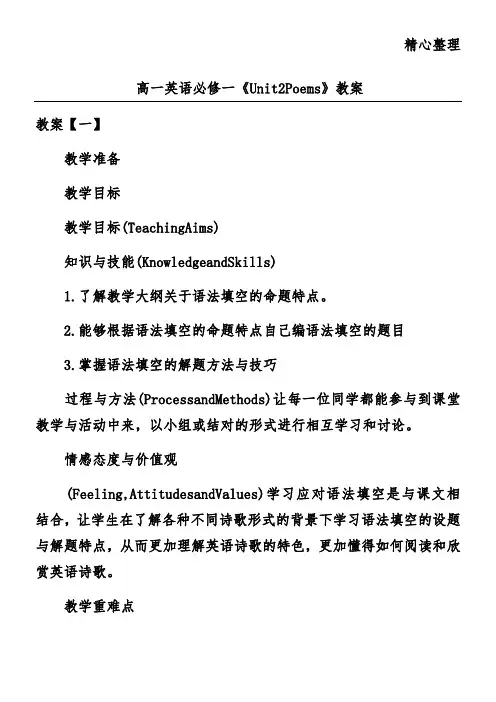
精心整理高一英语必修一《Unit2Poems》教案教案【一】教学准备结合,让学生在了解各种不同诗歌形式的背景下学习语法填空的设题与解题特点,从而更加理解英语诗歌的特色,更加懂得如何阅读和欣赏英语诗歌。
教学重难点教学重点(ImportantPoints):1.让学生了解语法填空的命题特点2.掌握语法填空的解题方法与技巧教学难点dsStepII:Pre-practising1.Questions①Doyouthinkitisdifficulttocomplete theitemsofblank-fillingw②Haveyoufiguredoutthecharacteristicsoftheitem?2.ExplainingInthisitemthereare10blanksforyoutofillinwithlessthanoneprop①___________________________________________.②___________________________________________.③___________________________________________.StepIII:While-practising1.Makinganitemofgrammaticalblank-fillingbasedontheparagraph ofthetext.①morethan5blanks.pleteEx.2onPage10,NanfangNewClass教案【二】教学准备教学目标Teachinggoals1.Targetlanguagea.ImportantwordsandphrasesAlotofTangpoetryhasbeentranslatedintoEnglish.Thetranslation shaveafreeformthatEnglishpeopleliketocopy.2.Abilitygoalsstpoems;cinquain,;haiku;Tangpoemsb.EnableSstotalkaboutdifferentpurposesofwritingpoems.c.Understandthemainthemeofeachpoem.d.EnableSstochantsomeoftheirfavoritepoems.3.Understandthemainpurposeofwritingthepoems.教学过程Teachingprocedures&waysStep1.GreetingsStep2.PresentationAskSstothinkbackandtrytorememberpoemsfromtheirearlychildhoo d,eitherinChineseorinEnglish.m”?TellSsthattherearemanyreasonswhypeoplewritepoetry.Givetheex amplesontheBb.AskSswhytheythinkthepoetswrotethepoemstheyhav ejustrecited..Writetheirsuggestionsontheboard.GiveSsatimelimitofafewminutes.Dividetheclassintogroupsoffou rtodiscussthepurposeofwritingpoems.Askonepersonfromeachgrou ptoreadtheirgroup’slistandaddtheirsuggestion stothelistonth eboard.(Suggestedreasons:tocreatecertainfeelingsorimagesint hereader;toshareafeelingorexperience;todescribesomethingindc.)Peoplefromdifferentcountrieswritedifferentkindsofpoems.GetS stodiscussthequestionsonPage9withtheirpartners:Doyouhaveafa voritepoeminChinese?Why?DoyouhaveafavoritepoeminEnglish?Why ?Astoexercise2,giveSspracticeinanimportantreadingskill:scann ingatext,thatis,lookingthroughatextquicklytofindspecificinf ormation.Readthetableinexercise2withtheSs.Tellthemthattheya regoingtolookfortheinformationinthetable,justinthepoemsthem selves,notintheotherpartsofthetext.Theyaretolookonlyforthos.Q1.Whydopeoplewritepoetry?Q2.Howmanyformsofpoemsarementionedinthepassage?Whatarethey?en?Q4.What’sthecharacteristicof“listpoems”?Whatabout“cinqu ain”?GetSstoreadthetextcarefully,findingtheonesentencethatsumsup theparagraphofeachpart..Underlinethetopicsentence.SecondreadingTellSsthattheyaregoingtolookattherhythmoftwoofthepoems.Make suretheyknowwhatrhythmis.ReadthelimerickaloudandhaveSsliste nforthestrongbeats.Thenhavethemclapthestrongbeatsasyouread. Markthestrongbeatsonthelimerickontheboard.Justasanyscenecanserveasthesubjectofapainting,soanypartofda ilylifecanprovidematerialforapoem..Ofcourse,thechoicethatth eartistorpoetmakesrelatestohisorherpurpose.Poetryisusuallys hortandcompact,soitshouldbereadseveraltimes,preferablyaloud ,toappreciateitsmeaning.Readthelastpoem(PoemH),andanswerthefollowingquestions:Q1.Whatpartsofthepoemsuggestthatthewomanlovesherhusband?ds.es?Homework1.Surfsomewebsitestofindoutmoreinformationaboutpoets.2.Reviewthecontentofthereadingpassage.3.FinishtheexercisesonPage12&13.。
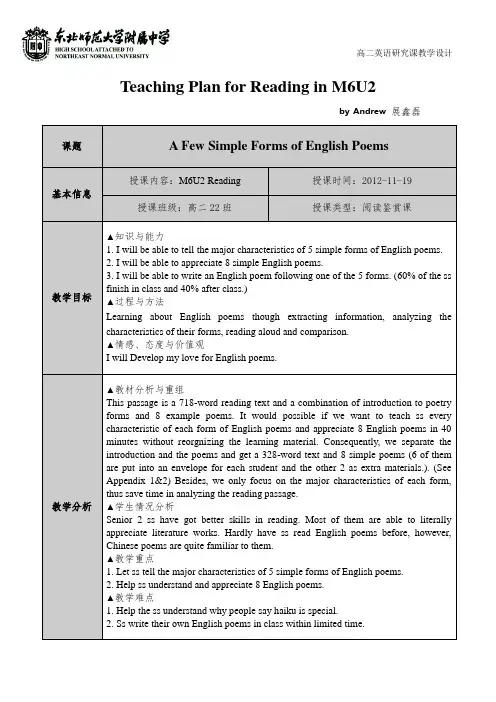
Teaching Plan for Reading in M6U2by Andrew展鑫磊课题 A Few Simple Forms of English Poems基本信息授课内容:M6U2 Reading授课时间:2012-11-19授课班级:高二22班授课类型:阅读鉴赏课教学目标▲知识与能力1. I will be able to tell the major characteristics of 5 simple forms of English poems.2. I will be able to appreciate 8 simple English poems.3. I will be able to write an English poem following one of the 5 forms. (60% of the ss finish in class and 40% after class.)▲过程与方法Learning about English poems though extracting information, analyzing the characteristics of their forms, reading aloud and comparison.▲情感、态度与价值观I will Develop my love for English poems.教学分析▲教材分析与重组This passage is a 718-word reading text and a combination of introduction to poetry forms and 8 example poems. It would possible if we want to teach ss every characteristic of each form of English poems and appreciate 8 English poems in 40 minutes without reorgnizing the learning material. Consequently, we separate the introduction and the poems and get a 328-word text and 8 simple poems (6 of them are put into an envelope for each student and the other 2 as extra materials.). (See Appendix 1&2) Besides, we only focus on the major characteristics of each form, thus save time in analyzing the reading passage.▲学生情况分析Senior 2 ss have got better skills in reading. Most of them are able to literally appreciate literature works. Hardly have ss read English poems before, however, Chinese poems are quite familiar to them.▲教学重点1. Let ss tell the major characteristics of 5 simple forms of English poems.2. Help ss understand and appreciate 8 English poems.▲教学难点1. Help the ss understand why people say haiku is special.2. Ss write their own English poems in class within limited time.高二英语研究课教学设计教学过程Teacher Students Comments1.Lead-in (2 min)T: Yesterday, we have learned about the basicknowledge of English poems by comparing themwith Chinese ones. Today, we will talk aboutanother important aspect of English poems. Look atthese Chinese poems. What are the differencesbetween them?T: (summarize ss’ answers into “form”) As you allknow, Chinese Poems have a variety of forms tofollow. Do you think the same thing exists inEnglish poems?T: (collect ss’ opinions) Yes or no? You’ll figure itout after this lesson..Compare thepresented Chinesepoems and find outthe differences.Know what we’regoing to learn aboutin this lesson.继续沿用上节Warming-up中使用的中英文诗歌对比学习的方法引导学生发现本课核心内容——英文诗歌的诗体。